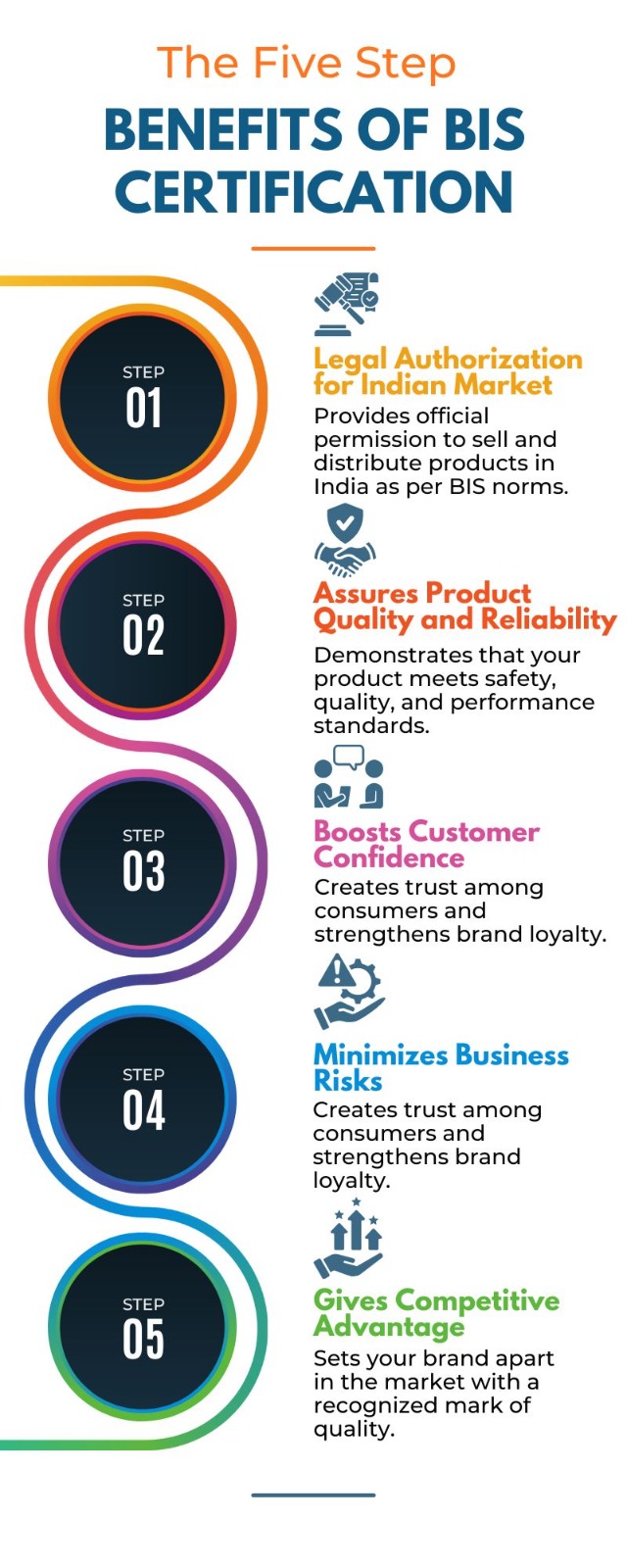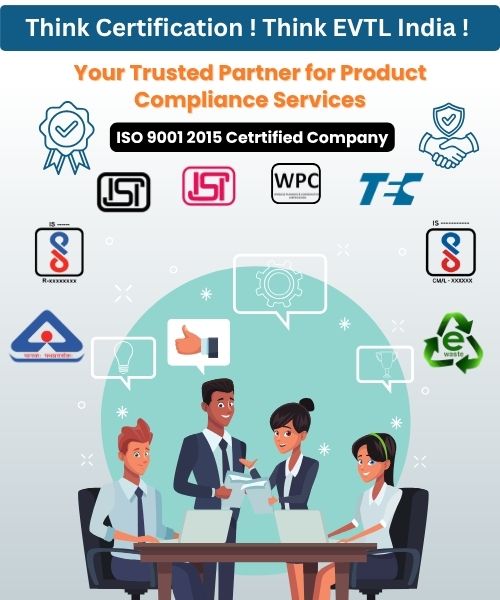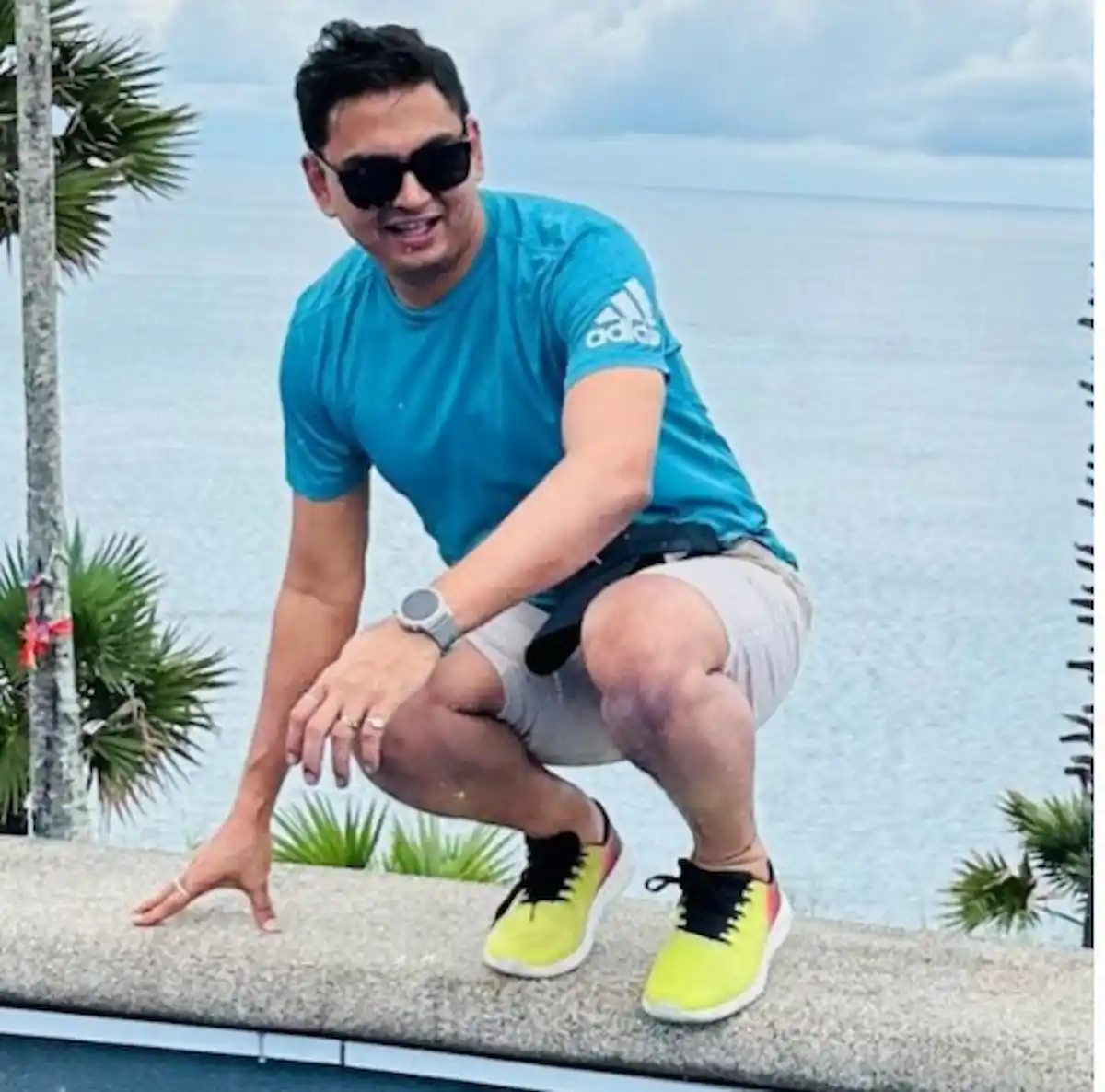Get A Quote
EPR Registration For E- Waste Management
Looking for a one-stop solution for EPR Registration for Electronic Waste (E-waste)? Look no further! EVTL India, your trusted EPR Registration consultant for E-waste in India, offers complete assistance in application filing, documentation, responsibilities guidance up to grant of EPR licence. Enjoy 24/7 free consultation with our top experts for all your queries. Think Certification Think EVTL India.

EPR E-waste - Overview
Extended Producer Responsibility (EPR) refers to the Producer and manufacture’s responsibility for taking care of a product and ensuring its environmentally friendly management throughout its entire life. EPR is essentially a waste management concept that encourages producer and manufactures to create products and manufacturing methods that are eco-friendly and easily recyclable.

Here, producers are individuals or entity involved in selling electrical and electronic equipment. This includes those who Make and sell these products under their own brand, or Sell assembled products under their brand made by others, or Sell imported electrical and electronic equipment, or Import used electrical and electronic equipment.
According to the EPR E-Waste (Management) Rules of 2022 the Extended Producer Responsibility (EPR) Framework is a set of rules for handling electronic waste. These rules apply to four types of entities: manufacturers, producers, refurbishers, and recyclers. To follow these rules, these entities must register on an online portal created by the Central Pollution Control Board. If an entity falls into more than one category, they need to register separately for each. It's not allowed for any entity to conduct business without being registered. Additionally, entities on the portal can only work with others who are also registered, and not with those who are not. Now talking about their responsibilities they need to follow as given below.
EPR Registration For Manufacturer's Responsibilities
EPR Registration For Producer's Responsibilities
EPR For Refurbisher's Responsibilities
EPR For Bulk Consumer's Responsibilities
EPR For Recycler's Responsibilities:
EPR Registration Type
Benefits Of Epr Registration Certificate
Obtaining ISI Mark certification from the Bureau of Indian Standards (BIS) offers numerous benefits for manufacturers, ensuring compliance with Indian standards and enhancing product credibility in the market. Here are some key benefits:
EPR Reduces Production Costs: EPR encourages recycling and reusing electronic waste, allowing manufacturers to save on raw materials and production costs by utilizing recycled materials.
Eco-Friendly Waste Management: EPR ensures environmentally friendly management of electronic, plastic, or battery waste, safeguarding the environment from harm through proper disposal and recycling practices.
Enhanced Product Reputation: Obtaining EPR Authorization from the Pollution Control Board acts as a seal of approval, signaling that the product is responsible and eco-friendly, thereby boosting its reputation and brand image in the market.
Promoting Sustainable Development:EPR, focused on sustainability, reduces waste generation and minimizes the misuse of natural resources by recycling and reusing electronic, plastic, or battery waste. This commitment contributes to sustainable development and protects the planet for future generations. The EPR registration certificate underscores a company's dedication to responsible and sustainable business practices.
EPR Registration Process For E-WASTE
The EPR Registration Process for EPR includes several steps, such as:
-
Application Process
- Producers need to apply for registration on the portal.
- Only online applications will be accepted; no physical applications will be considered.
- The application must be submitted through the designated portal.
-
Registration Validity:
- The registration will be valid for five years from the date of issuance of the EPR Registration Certificate for the producer.
- Producers must apply for renewal 120 days before the registration expires.
-
Application Requirements:
- To obtain registration, producers must provide basic information along with details of electrical and electronic equipment (EEE) placed in the market each financial year, specified by weight and covering the average end of life of their products.
- Producers need to submit self-declarations for RoHS compliance and ensure availability of documents as per EN 50581.
- Details of the awareness plan, as per Rule 6(3), must also be submitted.
-
Processing and Approval:
- Once an application is received on the portal, officials from the concerned Division of CPCB will review it.
- The application will be processed internally and submitted through the portal to the Competent Authority, CPCB, for approval.
- Upon approval, the Registration Certificate containing the EPR Registration Number, list of EEE, and EPR obligations will be issued to the producer through the portal.
-
Incomplete Applications:
- In case of an incomplete application, all shortcomings will be communicated through the portal to the producer within 25 working days.
- The producer has to respond within 07 working days through the portal.
- After receiving the reply, the application will be processed as described in point (4) above.
-
Issuing Registration:
- The CPCB (Central Pollution Control Board) will provide registration within 30 working days after receiving a complete application on the registration portal.
-
Verification and Response:
- If an application is incomplete, the CPCB may review it within 25 working days and share a digital checklist of shortcomings through the portal.
- The checklist will be issued by the relevant CPCB division, and producers can view it by logging into the portal with their credentials.
-
Clarifications in EPR Camp:
- Producers will have designated time slots in the EPR Camp, where they can discuss and seek clarification on the digital checklist through video conferencing.
-
Granting Registration:
- The CPCB may approve registration on the portal and issue the EPR Registration Certificate along with targets and obligations to producers based on the information provided in their application.
-
Registration fee:
- Producers will need to pay a registration fee, as per the decision of the Central Board in its 194th Board Meeting.
Documents Required For Epr Registration For E-Waste Management
| 1 | GST Certificate |
| 2 | Company Pan Card |
| 3 | Certification Of Incorporation (If Applicable) |
| 4 | Import – Export Code |
| 5 | Udyam Registration |
| 6 | Authorised Person Aadhar & Pan Card |
| 7 | Authorised Person Email Id & Contact No. |
| 8 | Company Letterhead (For CPCB Purpose) |
| 9 | Scanned Copy Of Company Stamp And Signature ( for uploading on the portal) |
| 10 | Product List (which registration is required) |
Epr Registration For E- Waste Management Fees
| No | Type of fees/Charges | Amount |
|---|---|---|
| 1 | Government Fees | As Applicable |
| 2 | Service Fees | 15,000/- |
List of Categories of Electrical and Electronic Equipment Cover under EPR Registration
| Categories of electrical and electronic equipment | EEE Code | Average Life |
|---|---|---|
| Information technology and telecommunication equipment | ||
| Centralized data processing | ITEW1 | |
| Mainframe | ITEW1 | 10 Years |
| Minicomputer | ITEW1 | 5 Years |
| Personal Computing: Personal Computers (Central Processing Unit with input and output devices) | ITEW2 | 6 Years |
| Personal Computing: Laptop Computers (Central Processing Unit with input and output devices) | ITEW3 | 5 Years |
| Personal Computing: Notebook Computers | ITEW4 | 5 Years |
| Personal Computing: Notepad Computers | ITEW4 | 5 Years |
| Printers including cartridges | ITEW6 | 10 Years |
| Copying equipment | ITEW7 | 8 Years |
| Electrical and electronic typewriters | ITEW8 | 5 Years |
| User terminals and systems | ITEW9 | 6 Years |
| Facsimile | ITEW10 | 10 Years |
| Telex | ITEW11 | 5 Years |
| Telephones | ITEW12 | 9 Years |
| Pay telephones | ITEW13 | 9 Years |
| Cordless telephones | ITEW14 | 9 Years |
| Cellular telephones | ITEW15 | |
| Feature phones | ITEW15 | 7 Years |
| Smart phones | ITEW15 | 5 Years |
| Answering systems | ITEW16 | 5 Years |
| Consumer electrical and electronics: | ||
| Television sets (including sets based on (Liquid Crystal Display and Light Emitting Diode technology)) | CEEW1 | 9 Years |
| Refrigerator | CEEW2 | 10 Years |
| Washing Machine | CCEW3 | 9 Years |
| Air-conditioners excluding centralized air conditioning plants | CCEW4 | 10 Years |
| Fluorescent and other Mercury containing lamps | CEEW5 | 2 Years |
Draft Average life proposed for the notified Electrical and Electronic Equipment (EEE) items under the E-Waste (Management) Rules, 2022
| Categories of electrical and electronic equipment | EEE Code | Average Life |
|---|---|---|
| Information technology and telecommunication equipment: | ||
| Products or equipment of Transmitting sound, images or other information by Telecommunications | ||
| (i). blacktooth enabled devices | ITEW17 | 3 |
| (ii). Telecommunication Antenna’s | ITEW17 | 7 |
| (iii). Transmitters | ITEW17 | 5 |
| (iv). Walkie talkie | ITEW17 | 5 |
| (v). Wi-Fi/wireless enabled Devices | ITEW17 | 3 |
| (vi). Radio/Satellite Telephone | ITEW17 | 7 |
| BTS (all components excluding structure of tower) | ITEW18 | 15 |
| Tablets, I-PAD | ITEW19 | 5 |
| Phablets | ITEW20 | 5 |
| Scanners | ITEW21 | 5 |
| Routers | ITEW22 | 10 |
| GPS | ITEW23 | 5 |
| UPS | ITEW24 | 5 – up to 2 KVA 7 – >2KVA |
| Inverter | ITEW25 | 5 – up to 2 KVA 7 – >2KVA |
| Modems | ITEW26 | 5 |
| Electronic data storage devices | ITEW27 | 5 – for flash drives (small devices) 10 – for large devices like Servers |
| Consumer Electrical and Electronics and Photovoltaic Panels: | ||
| Screen, Electronic Photo frames, Electronic Display Panel, Monitors | CEEW6 | 7 |
| Radio sets | CEEW7 | 8 |
| Set top Boxes | CEEW8 | 8 |
| Video Cameras | CEEW9 | 5 |
| Video Recorders | CEEW10 | 5 |
| Hi-Fi Recorders | CEEW11 | 5 |
| Audio Amplifiers | CEEW12 | 7 |
| Other products or equipment for the purpose of recording or reproducing sound or images including signals and other technologies for the distribution of sound and image by telecommunications | ||
| CCTV Camera with DVR & NVR | CEEW13 | 7 |
| Digital sound and video recorder and player | CEEW13 | 7 |
| Others products or equipment for the purpose of recording or reproducing sound or images including signals and other technologies for the distribution of sound and image by telecommunications | CEEW13 | 7 |
| Solar panels/cells, solar Photovoltaicpanels/cells/modules. | CEEW14 | 15 |
| Luminaires for fluorescent lamps with the exception of luminaires in households | CEEW15 | 2 |
| High intensity discharge lamps, including pressure sodium lamps and metal halide lamps | CEEW16 | 2 |
| Low pressure sodium lamps | CEEW17 | 2 |
| Digital camera | CEEW19 | 5 |
| Other lighting or equipment for the purpose of spreading or controlling light excluding filament bulbs | ||
| LED used by Consumers | CEEW18 | 3 |
| LED used for Professional purpose | CEEW18 | 5 |
| Large and Small Electrical and Electronic Equipment | ||
| Large cooling appliances | LSEEW1 | 10 |
| Freezers | LSEEW2 | 10 |
| Other large appliances used for refrigeration, conservation and storage of food | LSEEW3 | 10 |
| Clothes dryers | LSEEW4 | 10 |
| Dish Washing Machines | LSEEW5 | 10 |
| Electric cookers | LSEEW6 | 5 |
| Electric stoves | LSEEW7 | 5 |
| Electric hot plates | LSEEW8 | 5 |
| Microwaves, Microwave Oven | LSEEW9 | 7 |
| Other large appliances used for cooking and other processing of food | LSEEW10 | 10 |
| Electric heating appliances | LSEEW11 | 8 |
| Electric radiators | LSEEW12 | 7 |
| Other large appliances for heating rooms, beds, seating furniture | LSEEW13 | 7 |
| Electric fans | LSEEW14 | 15 |
| Other fanning, exhaust ventilation and conditioning equipment | LSEEW15 | 10 |
| Vacuum cleaners | LSEEW16 | 10 |
| Carpet sweepers | LSEEW17 | 10 |
| Other appliances for cleaning | LSEEW18 | 10 |
| Appliances used for sewing, knitting, weaving and other processing for textiles | LSEEW19 | 7 |
| Iron and other appliances for ironing, mangling and other care of clothing | LSEEW20 | 5 |
| Grinders, coffee machines and equipment for opening or sealing containers or packages | LSEEW21 | 7 |
| Smoke detector | LSEEW22 | 10 |
| Heating Regulators | LSEEW23 | 5 |
| Thermostats | LSEEW24 | 5 |
| Automatic dispensers for hot drinks | LSEEW25 | 7 |
| Automatic dispensers for hot or cold bottles or cans | LSEEW26 | 7 |
| Automatic dispensers for solid products | LSEEW27 | 10 |
| Automatic dispensers for money | LSEEW28 | 10 |
| All appliances which deliver automatically all kinds of products | LSEEW29 | 10 |
| Indoor air purifier | LSEEW30 | 10 |
| Hair dryer | LSEEW31 | 3 |
| Electric shaver | LSEEW32 | 3 |
| Electric kettle | LSEEW33 | 5 |
| Electronic display panels/board/visual display unit | LSEEW34 | 5 |
| Electrical and Electronic Tools (With the exception of large- Scale Stationary Industrial Tools) | ||
| Drills | EETW1 | 8 |
| Saws | EETW2 | 10 |
| Sewing Machines | EETW3 | 15 |
| Equipment for turning, milling, sanding, grinding, sawing, cutting, shearing, drilling, making holes, punching, folding, bending or similar processing of wood, metal and other materials | EETW4 | 10 |
| Tools for riveting, nailing or screwing or removing rivets, nails, screws or similar uses | EETW5 | 10 |
| Tools for welding, soldering, or similar use | EETW6 | 10 |
| Equipment for spraying, spreading, dispersing or other treatment of liquid or gaseous substance by other means | EETW7 | 10 |
| Tools for mowing or other gardening activities | EETW8 | 10 |
| Toys, Leisure and Sports Equipment | ||
| Electrical trains or car racing sets | TLSEW1 | 2 |
| Hand-held video games consoles | TLSEW2 | 2 |
| Video games | TLSEW3 | 2 |
| Computers for biking, diving, running, rowing, etc. | TLSEW4 | 3 |
| Sports equipment with electric or electronic components | TLSEW5 | 5 |
| Coin slot machines | TLSEW6 | 8 |
| Medical Devices (With the Exception of All Implanted and Infected Products) | ||
| Radiotherapy equipment and accessories | MDW1 | 20 |
| Cardiology equipment and accessories | MDW2 | 10 |
| Dialysis equipment and accessories | MDW3 | 10 |
| Pulmonary ventilators and accessories | ||
| Diagnostic Cardiology | MDW4 | 7 |
| Anaesthesia & Respiratory | MDW4 | 10 |
| Nuclear Medicine Equipment and accessories | MDW5 | 20 |
| Laboratory equipment for in vitro diagnosis and accessories | MDW6 | 15 |
| Analysers and accessories | MDW7 | 10 |
| Magnetic Resonance Imaging (MRI), Positron Emission Tomography (PET) Scanner, Computed Tomography Scanner, & Ultrasound Equipment along with accessories | ||
| MRI | MDW8 | 20 |
| PET CT/PET | MDW8 | 20 |
| SPECT CT/ SPECT | MDW8 | 20 |
| CT | MDW8 | 20 |
| US | MDW8 | 7 |
| Fertilization tests equipment and accessories | MDW9 | 10 |
| Maternal & Infant care products | MDW10 | 7 |
| C-Arm | MDW10 | 7 |
| Monitoring Solution products/High end | MDW10 | 15 |
| X-ray and fluoroscopy | MDW10 | 10 |
| Mammography devices | MDW10 | 10 |
| Other electric appliances/equipment/kits used for preventing, screening, detecting, monitoring, evaluating, reviewing, examining, investigating, probing, treating illness sickness, disease, disorder, affliction, infection, injury, trauma, abuse or disability including the Mobiles, Tablets or any other device with the features having the potential of sex selection and their accessories | MDW10 | 7 |
| Laboratory Instruments | ||
| Gas analyser | LIW1 | 8 |
| Equipment having electrical and electronic components | LIW2 | 8 |
Conclusion:
Extended Producer Responsibility (EPR) is an important responsibility of a producer in India that makes producers responsible for handling the electronic waste from the products they make or import. To follow this rule, producers need to go through the EPR registration process with the Central Pollution Control Board (CPCB) if they operate with electrical and electronic equipment in the Indian market.
Understanding the EPR certificate requirements is essential for a smooth certification process and compliance with environmental standards. Entities that embrace EPR registration and certification contribute to a greener and more responsible electronic waste management ecosystem.
Frequently Asked Questions (FAQ)
Our Services
News & Updates









